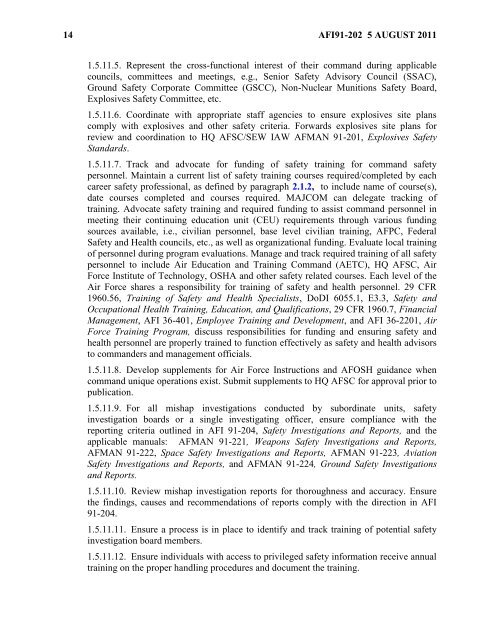MEMORANDUM FOR A1 - Air Force E-Publishing
MEMORANDUM FOR A1 - Air Force E-Publishing
MEMORANDUM FOR A1 - Air Force E-Publishing
You also want an ePaper? Increase the reach of your titles
YUMPU automatically turns print PDFs into web optimized ePapers that Google loves.
14 AFI91-202 5 AUGUST 2011<br />
1.5.11.5. Represent the cross-functional interest of their command during applicable<br />
councils, committees and meetings, e.g., Senior Safety Advisory Council (SSAC),<br />
Ground Safety Corporate Committee (GSCC), Non-Nuclear Munitions Safety Board,<br />
Explosives Safety Committee, etc.<br />
1.5.11.6. Coordinate with appropriate staff agencies to ensure explosives site plans<br />
comply with explosives and other safety criteria. Forwards explosives site plans for<br />
review and coordination to HQ AFSC/SEW IAW AFMAN 91-201, Explosives Safety<br />
Standards.<br />
1.5.11.7. Track and advocate for funding of safety training for command safety<br />
personnel. Maintain a current list of safety training courses required/completed by each<br />
career safety professional, as defined by paragraph 2.1.2, to include name of course(s),<br />
date courses completed and courses required. MAJCOM can delegate tracking of<br />
training. Advocate safety training and required funding to assist command personnel in<br />
meeting their continuing education unit (CEU) requirements through various funding<br />
sources available, i.e., civilian personnel, base level civilian training, AFPC, Federal<br />
Safety and Health councils, etc., as well as organizational funding. Evaluate local training<br />
of personnel during program evaluations. Manage and track required training of all safety<br />
personnel to include <strong>Air</strong> Education and Training Command (AETC), HQ AFSC, <strong>Air</strong><br />
<strong>Force</strong> Institute of Technology, OSHA and other safety related courses. Each level of the<br />
<strong>Air</strong> <strong>Force</strong> shares a responsibility for training of safety and health personnel. 29 CFR<br />
1960.56, Training of Safety and Health Specialists, DoDI 6055.1, E3.3, Safety and<br />
Occupational Health Training, Education, and Qualifications, 29 CFR 1960.7, Financial<br />
Management, AFI 36-401, Employee Training and Development, and AFI 36-2201, <strong>Air</strong><br />
<strong>Force</strong> Training Program, discuss responsibilities for funding and ensuring safety and<br />
health personnel are properly trained to function effectively as safety and health advisors<br />
to commanders and management officials.<br />
1.5.11.8. Develop supplements for <strong>Air</strong> <strong>Force</strong> Instructions and AFOSH guidance when<br />
command unique operations exist. Submit supplements to HQ AFSC for approval prior to<br />
publication.<br />
1.5.11.9. For all mishap investigations conducted by subordinate units, safety<br />
investigation boards or a single investigating officer, ensure compliance with the<br />
reporting criteria outlined in AFI 91-204, Safety Investigations and Reports, and the<br />
applicable manuals: AFMAN 91-221, Weapons Safety Investigations and Reports,<br />
AFMAN 91-222, Space Safety Investigations and Reports, AFMAN 91-223, Aviation<br />
Safety Investigations and Reports, and AFMAN 91-224, Ground Safety Investigations<br />
and Reports.<br />
1.5.11.10. Review mishap investigation reports for thoroughness and accuracy. Ensure<br />
the findings, causes and recommendations of reports comply with the direction in AFI<br />
91-204.<br />
1.5.11.11. Ensure a process is in place to identify and track training of potential safety<br />
investigation board members.<br />
1.5.11.12. Ensure individuals with access to privileged safety information receive annual<br />
training on the proper handling procedures and document the training.
















